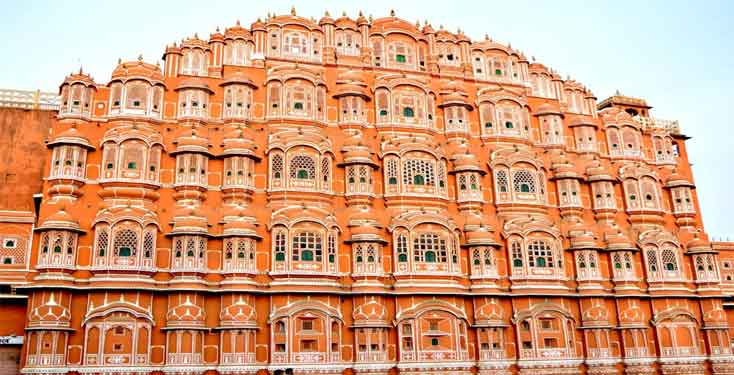Hawa Mahal TRAVEL GUIDE

Hawa Mahal is a luxurious palace situated in Jaipur, India. In fact, this is a large walled wall, which was mainly made for the royal family's women so that they can enjoy the festivals and festivals on the road from within, because they were not allowed to go out. This fort has been constructed with red and pink sandstone stones, this palace is located on the edge of the City Palace and spreads to the women's room.
History of Hawa Mahal Jaipur
This palace was constructed in the year 1799 by Maharaja Sawai Pratap Singh. The palace's design was made by Lal Chand Ustad as the crown of Hindu God Krishna. The unique five-storeyed outer part of the palace recruits the honey bees of bees, which has 953 small windows, which is also called the window. The work of the unique lattice has been done in the windows. The main reason for applying these nets was that the women of the royal house could see the everyday life of the street, which they could not see and go out because they used to follow the "curtain" covering (face cover). The cold air is transmitted in the inner part of the palace complex by these fishes, as well as air conditioning for the entire area in high temperatures of summer.
During 2006, the repair and renovation work of this palace was started, which was done after about 50 years of intervals. The cost of the palace was estimated to cost about 4568 million rupees. A corporate sector took over the responsibility of preserving all the historic monuments of Jaipur and the Unit Trust of India took responsibility for maintaining the Hawa Mahal. This palace is a spacious part of the vast area. The features of this palace include some carved stone films, small windows and arched ceilings. Like the rest of Jaipur's other monuments, this palace has also been constructed with red and pink sandstone.
How to Reach Hawa Mahal
The Hawa Mahal lies on the a major street crossing point known as Badi Chaupar, one of the prime territories of Jaipur. Jaipur Railway Station is nearest railway station which lies at a separation of 5.2 km from this royal residence. On the off chance that you take a taxi, you can achieve this structure in roughly a short ways from Jaipur International Airport.
Time to visit Hawa Mahal
9.00 am to 5.00 pm
Hawa Mahal Location
Architecture of Hawa Mahal
This palace is a five-storey pyramidal memorial, which is 50 feet (15 m) above its base. The circumference of the structure of the upper three floors of the palace is equal to the breadth of a room, while the patio is in front of the first and second floors. From the front of the palace, which can be seen from the road, which looks like honey bees of bees and also has small windows. Each window of the palace has miniature windows and carved sandstone, finials and clusters. It shows the presence of a group of semi octagonal clusters, which makes it a unique face of this monument. According to the requirement in the interior premises behind the palace building, the rooms have been constructed with khambo and corridors have been constructed with a light decoration, by which the top floor is reached. Many rooms made of stone of different colors within the air, help with the help of gold and a fountain which is located in the center of the courtyard.
The architect Lal Chand Ustad was the real architect of this unique structure. As you all know, Jaipur also has the title of "Pink City" as it has used red and pink colors in the construction of most of the monuments, due to which this palace is also made of red and pink sandstone. . There are 953 alarms on the palace's face, in which there are carved vestures (some of which also belong to the girl), which is exactly the opposite of the last part of the palace (which is quite common in appearance). Its cultural and architectural heritage, the true architecture of Hindu Rajput architecture and the blend of Islamic Mughal architecture. In Rajput architecture, the shape of the umbrella umbrellas, fluted columns, lotus and flower statues is compiled, whereas in the Islamic architecture, the stone work is done by the fine work of Chandi and the arches (according to the similarity of the Panchmahal - which is located in Fatehpur Sikri).
© Copyright 2018 Design ByIndia Easy TripAll Rights Reserved

